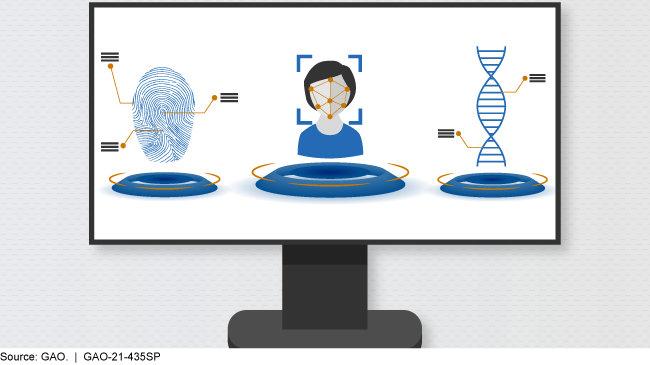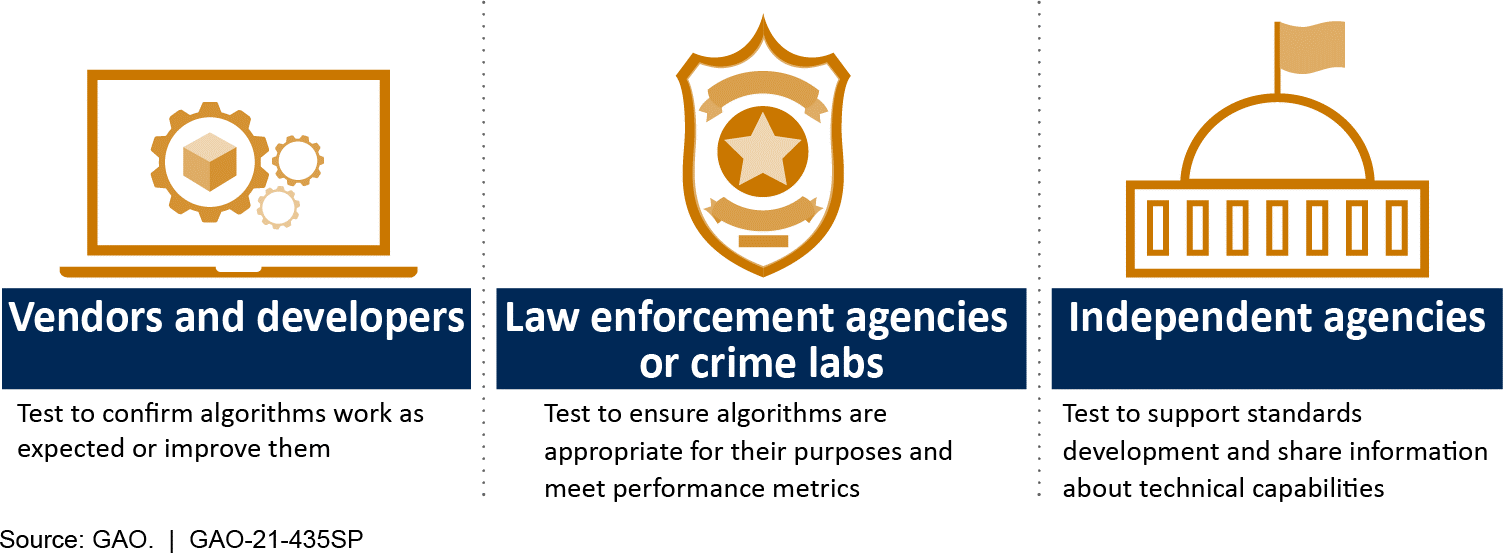Forensic Technology: Algorithms Strengthen Forensic Analysis, but Several Factors Can Affect Outcomes
Fast Facts
Law enforcement agencies use forensic algorithms in criminal investigations to help assess whether evidence originated from a specific individual—improving the speed and objectivity of many investigations.
However, analysts and investigators face several challenges, such as difficulty interpreting and communicating results, and addressing potential bias and misuse.
We developed three policy options that could help with such challenges:
- Increased training
- Standards and policies on appropriate use
- Increased transparency in testing, performance, and use of these algorithms
Forensic algorithms can help analyze latent fingerprints, faces, genetic information, and more

Highlights
What GAO Found
Law enforcement agencies primarily use three kinds of forensic algorithms in criminal investigations: latent print, facial recognition, and probabilistic genotyping. Each offers strengths over related, conventional forensic methods, but analysts and investigators also face challenges when using them to assist in criminal investigations.
Latent print algorithms help analysts compare details in a latent print from a crime scene to prints in a database. These algorithms can search larger databases faster and more consistently than an analyst alone. Accuracy is assessed across a variety of influencing factors, including image quality, number of image features (e.g., ridge patterns) identified, and variations in the feature mark-up completed by analysts. GAO identified several limitations and challenges to the use of these algorithms. For example, poor quality latent or known prints can reduce accuracy.
Facial recognition algorithms help analysts extract digital details from an image and compare them to images in a database. These algorithms can search large databases faster and can be more accurate than analysts. The accuracy of these algorithms is assessed across a variety of influencing factors, including image quality, database size, and demographics. GAO identified several challenges to the use of these algorithms. For example, human involvement can introduce errors, and agencies face challenges in testing and procuring the algorithms that are most accurate and that have minimal differences in performance across demographic groups.
Probabilistic genotyping algorithms help analysts evaluate a wider variety of DNA evidence than conventional analysis—including DNA evidence with multiple contributors or partially degraded DNA—and compare such evidence to DNA samples taken from persons of interest. These algorithms provide a numerical measure of the strength of evidence called the likelihood ratio. To assess these algorithms, law enforcement agencies and others test the influence of several factors on the likelihood ratio, including DNA sample quality, amount of DNA in the sample, number of contributors, and ethnicity or familial relationships. GAO identified two challenges to the use of these algorithms. For example, likelihood ratios are complex and there are no standards for interpreting or communicating the results as they relate to probabilistic genotyping.
Generally, three entities test forensic algorithms to ensure they are reliable for law enforcement use.

GAO developed three policy options that could help address challenges related to law enforcement use of forensic algorithms. The policy options identify possible actions by policymakers, which may include Congress, other elected officials, federal agencies, state and local governments, and industry. See below for details of the policy options and relevant opportunities and considerations.
Policy Options to Help Address Challenges with the Use of Forensic Algorithms
| Policy option | Opportunities | Considerations |
|
Increased training (report p. 44) Policymakers could support increased training for analysts and investigators. |
|
|
|
Standards and policies on appropriate use (report p. 45) Policymakers could support development and implementation of standards and policies on appropriate use of algorithms. |
|
|
|
Increased transparency (report p. 46) Policymakers could support increased transparency related to testing, performance, and use of algorithms. |
|
|
Why GAO Did This Study
For more than a century, law enforcement agencies have examined physical evidence to help identify persons of interest, solve cold cases, and find missing or exploited people. Forensic experts are now also using algorithms to help assess evidence collected in a criminal investigation, potentially improving the speed and objectivity of their investigations.
GAO was asked to conduct a technology assessment on the use of forensic algorithms in law enforcement. In a prior report (GAO-20-479SP), GAO described algorithms used by federal law enforcement agencies and how they work. This report discusses (1) the key performance metrics for assessing latent print, facial recognition, and probabilistic genotyping algorithms; (2) the strengths of these algorithms compared to related forensic methods; (3) challenges affecting their use; and (4) policy options that may help address these challenges.
In conducting this assessment, GAO interviewed federal officials, select non-federal law enforcement agencies and crime laboratories, algorithm vendors, academic researchers, and nonprofit groups; convened an interdisciplinary meeting of 16 experts with assistance from the National Academies of Sciences, Engineering, and Medicine; and reviewed relevant literature. GAO is identifying policy options in this report.
For more information, contact Karen L. Howard at (202) 512-6888 or howardk@gao.gov.
